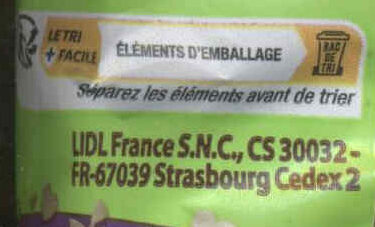Œufs Croustillants - Lait - Noir - Blanc - Favorina - 200 g
Ambiguous barcode: This product has a Restricted Circulation Number barcode for products within a company. This means that different producers and stores can use the same barcode for different products.
×
Barcode: 20462567
Common name: Bonbons de chocolat: Céréales coustillantes (20%) enrobées de chocolat au lait, noir et blanc (80%)
Quantity: 200 g
Packaging: Plastic, Metal, Bag, Fastener
Categories: Snacks, Sweet snacks, Cocoa and its products, Confectioneries, Festive foods, Chocolate candies, Bonbons, Easter food, Chocolate eggs, Easter eggs
Labels, certifications, awards:
Fair trade, Fairtrade International, Sustainable farming, Triman

Origin of the product and/or its ingredients: CACAO ORIGINE : Côte d'Ivoire
Origin of ingredients: Côte d'Ivoire, Unspecified
Manufacturing or processing places: France
Stores: Lidl
Countries where sold: France
Matching with your preferences
Report a problem
Data sources
Product added on by sonial
Last edit of product page on by bugmenot.
Product page also edited by autorotate-bot, foodrepo, inf, kiliweb, moon-rabbit, openfoodfacts-contributors, packbot, quechoisir, roboto-app, telimel, teolemon, yuka.WUxCZUFya2htc2s3bk1JczVTek15TzFNNDRUekFVRzBMZWhNSVE9PQ, yuka.sY2b0xO6T85zoF3NwEKvlklJU_HmjCrgPT7ilEyK-eu0C7rmXMhywprGE6s.













